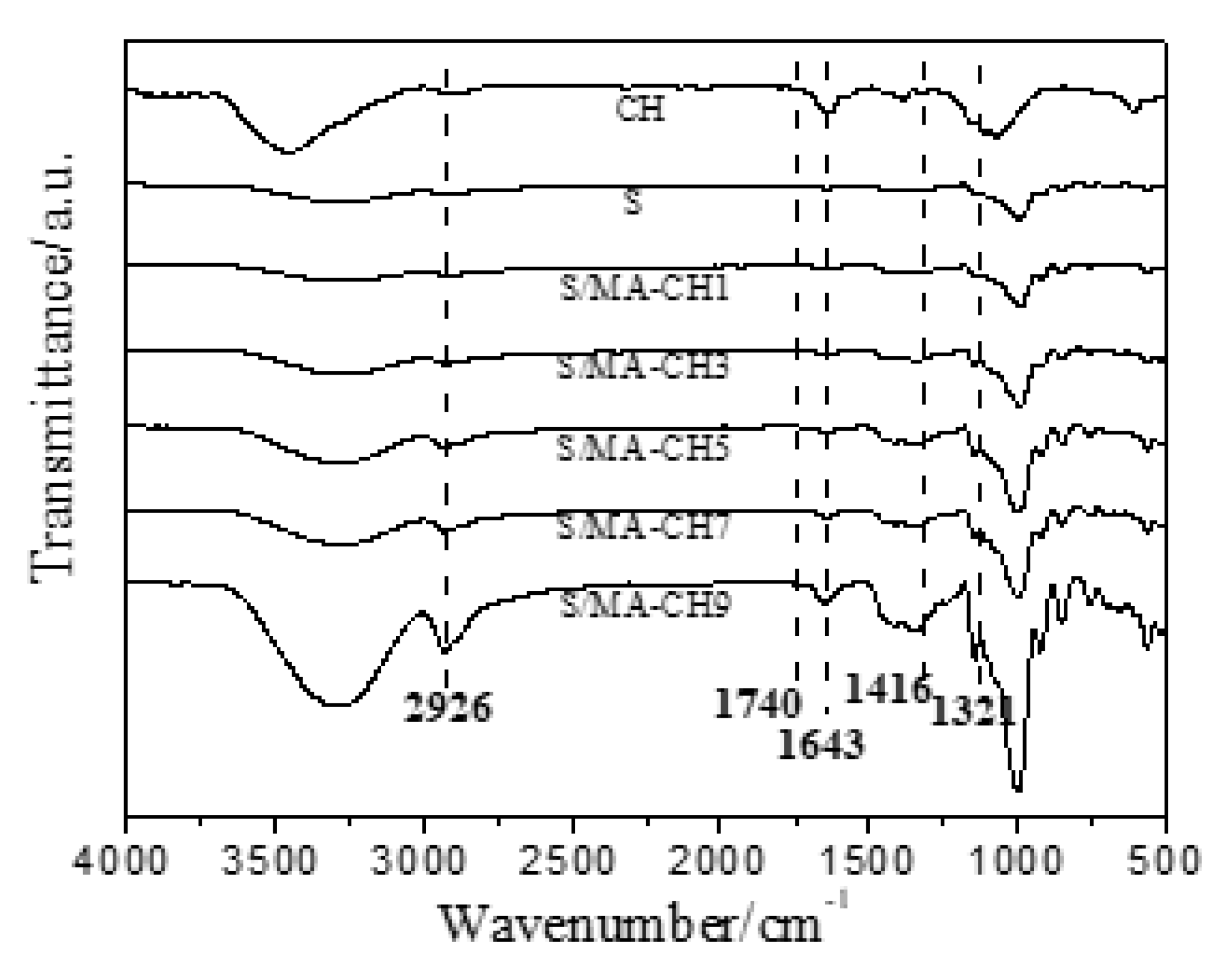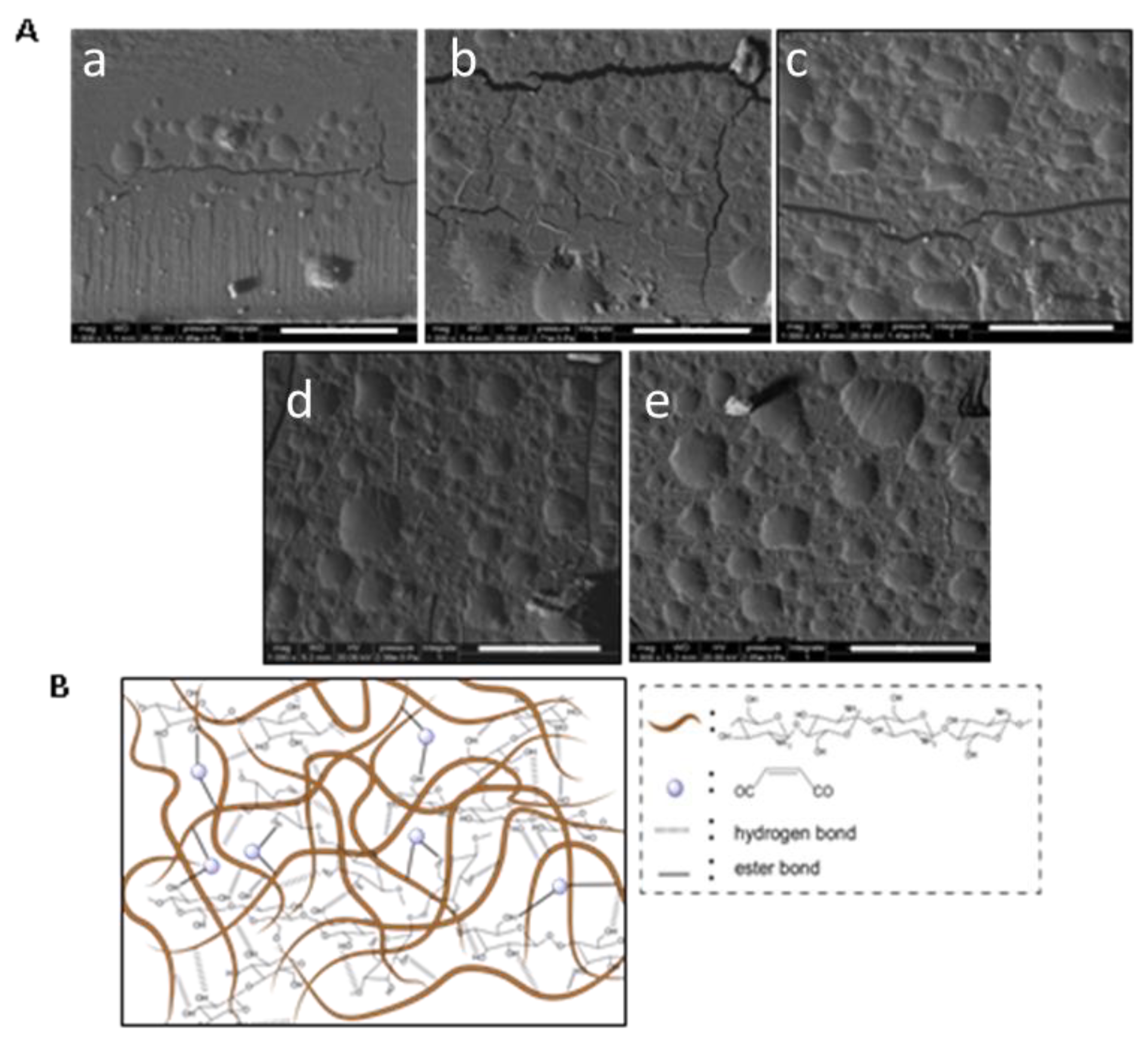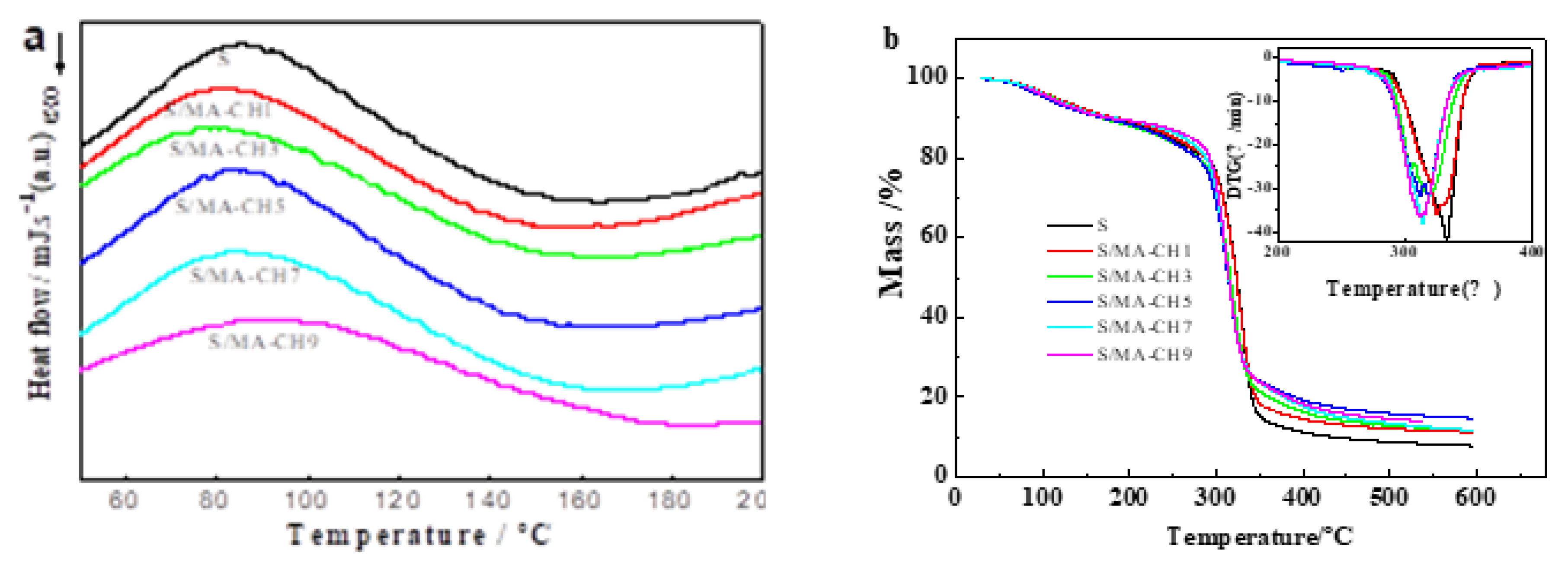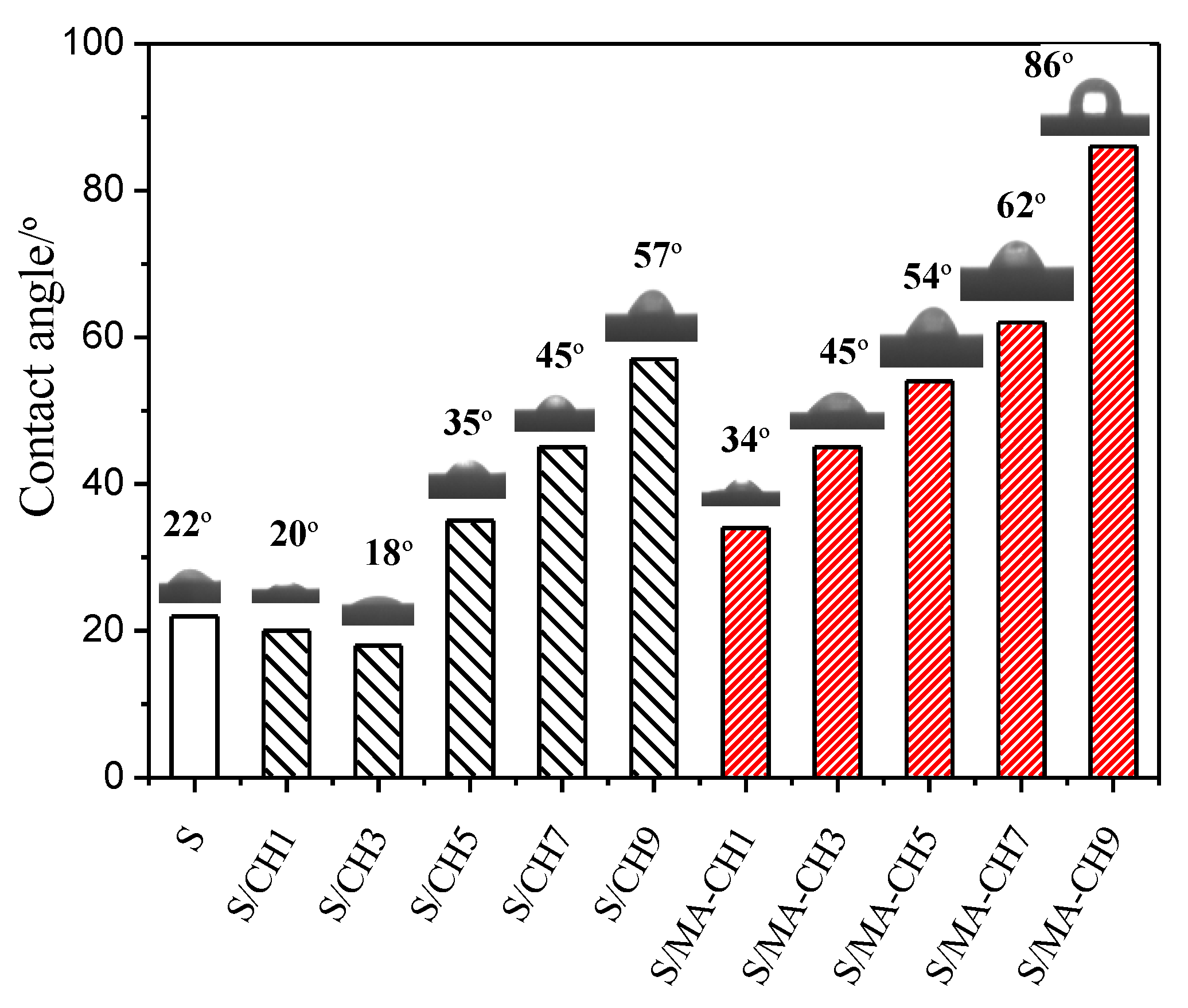Preparation and Properties of Corn Starch/Chitin Composite Films Cross-Linked by Maleic Anhydride
Abstract
1. Introduction
2. Materials and Methods
2.1. Materials
2.2. Preparation of Chitin Nanoparticles
2.3. Maleic Anhydride Modification and Film Preparation
2.4. Fourier Transforms Infrared Spectroscopy
2.5. Tensile Measurements
2.6. Contact Angle
2.7. Scanning Electron Microscope
2.8. Differential Scanning Calorimetry and Thermogravimetric Analysis
2.9. Water Uptake
2.10. Water Vapor Permeability (WVP)
2.11. Antibacterial Activity
3. Results and Discussion
3.1. Mechanical Properties
3.2. Reaction Mechanism
3.3. Morphological Characterization
3.4. Thermal Analysis
3.5. Contact Angle
3.6. Water Vapor Permeability and Moisture Absorption
3.7. Antibiotic Activity of Composite Films
4. Conclusions
Supplementary Materials
Author Contributions
Funding
Acknowledgments
Conflicts of Interest
References
- Doane, W.; Swanson, C.; Fanta, G. Emerging polymeric materials based on starch. ACS Symp. Ser. 1992, 476, 197–230. [Google Scholar]
- Avella, M.; De Vliegar, J.J.; Errico, M.E. Biodegradable starch/clay nanocomposites films for food packaging applications. Food Chem. 2005, 93, 467–474. [Google Scholar] [CrossRef]
- Lorcks, J. Properties and applications of compostable starch-based plastic material. Polym. Degrad. Stab. 1998, 59, 245–249. [Google Scholar] [CrossRef]
- Ghanbarzadeh, B.; Oromiehi, A.R. Thermal and mechanical behavior of laminated protein films. J. Food Eng. 2009, 90, 517–524. [Google Scholar] [CrossRef]
- Khan, B.; Niazi, M.B.K.; Samin, G.; Jahan, Z. Thermoplastic starch: A possible biodegradable food packaging material-a review. J. Food Process Eng. 2017, 40, e12447. [Google Scholar] [CrossRef]
- Averous, L.; Fringant, C.; Moro, L. Starch-based biodegradable materials suitable for thermoforming packaging. Starch Starke 2001, 53, 368–371. [Google Scholar] [CrossRef]
- Smits, A.L.M.; Kruiskamp, P.H.; van Soest, J.J.G.; Vliegenthart, J.F.G. Interaction between dry starch and plasticisers glycerol or ethylene glycol, measured by differential scanning calorimetry and solid state NMR spectroscopy. Carbohydr. Polym. 2003, 53, 409–416. [Google Scholar] [CrossRef]
- Teixeira, E.D.; Pasquini, D.; Curvelo, A.A.S.; Corradini, E.; Belgacem, M.N.; Dufresne, A. Cassava bagasse cellulose nanofibrils reinforced thermoplastic cassava starch. Carbohydr. Polym. 2009, 78, 422–431. [Google Scholar] [CrossRef]
- Niazi, M.B.K.; Zijlstra, M.; Broekhuis, A.A. Understanding the role of plasticisers in spray-dried starch. Carbohydr. Polym. 2013, 97, 571–580. [Google Scholar] [CrossRef]
- Niazi, M.B.K.; Broekhuis, A.A.; Broekhuis, A.A. Influence of plasticizer with different functional groups on thermoplastic starch. App. Polym. Sci. 2015, 132, 42012. [Google Scholar] [CrossRef]
- Amirah, H.M.Z.; Mohamad Kahar, A.W.; Hanafi, I. Biodegradation behaviour of thermoplastic starch: The roles of carboxylic acids on cassava starch. J. Polym. Environ. 2018, 26, 691–700. [Google Scholar]
- Munlika, B.; Kaewta, K. Biodegradation of thermoplastic starch/eggshell powder composites. Carbohydr. Polym. 2013, 97, 315–320. [Google Scholar]
- Munlika, B.; Kaewta, K. Biodegradability, mechanical, and thermal properties of thermoplastic starch/cuttlebone composites. Polym. Composite. 2015, 36, 1401–1406. [Google Scholar]
- Mohan, T.P.; Devchand, K.; Kanny, K. Barrier and biodegradable properties of corn starch-derived biopolymer film filled with nanoclay fillers. J. Plast. Sheet. 2017, 33, 309–336. [Google Scholar] [CrossRef]
- Salaberria, A.M.; Labidi, J.; Fernandes, S.C.M. Chitin nanocrystals and nanofibers as nano-sized fillers into thermoplastic starch-based biocomposites processed by melt-mixing. Chem. Eng. J. 2014, 256, 356–364. [Google Scholar] [CrossRef]
- Terrazas-Hernandez, J.A.; Berrios, J.D.; Glenn, G.M.; Imam, S.H.; Wood, D.; Bello-Perez, L.A.; Vargas-Torres, A. Properties of cast films made of chayote (sechium edule sw.) tuber starch reinforced with cellulose nanocrystals. J. Polym. Environ. 2015, 23, 30–37. [Google Scholar] [CrossRef]
- Tomasz, O.; Agnieszka, W.; Leszek, M.; Marcin, M.; Karol, K.; Andrzej, K.; Grzegorz, B. Effect of natural fibres on the mechanical properties of thermoplastic starch. Int. Agrophys. 2016, 30, 211–218. [Google Scholar]
- Dufresne, A.; Castano, J. Polysaccharide nanomaterial reinforced starch nanocomposites: A review. Starch/Stärke 2017, 69, 1500307. [Google Scholar] [CrossRef]
- Zeng, J.B.; He, Y.S.; Li, S.L.; Wang, Y.Z. Chitin whiskers: An overview. Biomacromolecules 2012, 13, 1–11. [Google Scholar] [CrossRef]
- Zhai, M.L.; Zhao, L.; Yoshii, F.; Kume, T. Study on antibacterial starch/chitosan blend film formed under the action of irradiation. Carbohydr. Polym. 2004, 57, 83–88. [Google Scholar] [CrossRef]
- Weska, R.F.; Moura, J.M.; Batista, L.M.; Rizzi, J.; Pinto, L.A.A. Optimization of deacetylation in the production of chitosan from shrimp wastes: Use of response surface methodology. J. Food Eng. 2007, 80, 749–753. [Google Scholar] [CrossRef]
- Bertolino, V.; Cavallaro, G.; Lazzara, G.; Milioto, S.; Parisi, F. Halloysite nanotubes sandwiched between chitosan layers: Novel bionanocomposites with multilayer structures. New J. Chem. 2018, 42, 8384–8390. [Google Scholar] [CrossRef]
- Salvo-Comino, C.; Rassas, I.; Minot, S.; Bessueille, F.; Arab, M.; Chevallier, V.; Rodriguez-Mendez, M.L.; Errachid, A.; Jaffffrezic-Renault, N. Voltammetric sensor based on molecularly imprinted chitosan-carbon nanotubes decorated with gold nanoparticles nanocomposite deposited on boron-doped diamond electrodes for catechol detection. Materials 2020, 13, 688. [Google Scholar] [CrossRef] [PubMed]
- Freire, T.M.; Fechine, L.M.U.D.; Queiroz, D.C.; Freire, R.M.; Denardin, J.C.; Ricardo, N.M.P.S. Magnetic porous controlled Fe3O4-chitosan nanostructure: An ecofriendly adsorbent for efficient removal of azo dyes. Nanomaterials 2020, 10, 1194. [Google Scholar] [CrossRef]
- Lisuzzo, L.; Cavallaro, G.; Parisi, F.; Milioto, S.; Fakhrullin, R.; and Lazzara, G. Core/shell gel beads with embedded halloysite nanotubes for controlled drug release. Coatings 2019, 9, 70. [Google Scholar] [CrossRef]
- Qin, Y.; Zhang, S.L.; Yu, J.; Yang, J.; Xiong, L.; Sun, Q.J. Effects of chitin nano-whiskers on the antibacterial andphysicochemical properties of maize starch films. Carbohydr. Polym. 2016, 147, 372–378. [Google Scholar] [CrossRef]
- Salaberria, A.M.; Diaz, R.H.; Labidi, J.; Fernandes, S.C.M. Role of chitin nanocrystals and nanofibers on physical, mechanical and functional properties in thermoplastic starch films. Food Hydrocoll. 2015, 46, 93–102. [Google Scholar] [CrossRef]
- Lopez, O.; Garcia, M.A.; Villar, M.A.; Gentili, A.; Rodriguez, M.S.; Albertengo, L. Thermo-compression of biodegradable thermoplastic corn starch films containing chitin and chitosan. LWT Food Sci. Technol. 2014, 57, 106–115. [Google Scholar] [CrossRef]
- Mendes, J.F.; Paschoalin, R.T.; Carmona, V.B.; Sena Neto, A.R.; Marques, A.C.P.; Marconcini, M.; Mattoso, L.H.C.; Medeiros, E.S.; Oliveira, J.E. Biodegradable polymer blends based on corn starch and thermoplastic chitosan processed by extrusion. Carbohydr. Polym. 2016, 137, 452–458. [Google Scholar] [CrossRef]
- Dang, K.M.; Yoksan, R. Morphological characteristics and barrier properties of thermo plastic starch/chitosan blown film. Carbohydr. Polym. 2016, 150, 40–47. [Google Scholar] [CrossRef]
- Valencia-Sullca, C.; Vargas, M.; Atares, L.; Chiralt, A. Thermoplastic cassava starch-chitosan bilayer films containing essential oils. Food Hydrocoll. 2018, 75, 107–115. [Google Scholar] [CrossRef]
- Chang, P.R.; Jian, R.J.; Yu, J.G.; Ma, X.F. Starch-based composites reinforced with novel chitin nanoparticles. Carbohydr. Polym. 2010, 80, 420–425. [Google Scholar] [CrossRef]
- Xie, F.; Pollet, E.; Halley, P.J.; Averous, L. Starch-based nano-biocomposites. Prog. Polym. Sci. 2013, 38, 1590–1628. [Google Scholar] [CrossRef]
- Wu, H.; Lei, Y.; Lu, J.; Zhu, R.; Xiao, D.; Jiao, C.; Xia, R.; Zhang, Z.; Shen, G.; Liu, Y.; et al. Effect of citric acid induced crosslinking on the structure and properties of potato starch/chitosan composite films. Food Hydrocoll. 2019, 97, 105208. [Google Scholar] [CrossRef]
- Palpandi, C.; Shanmugam, V.; Shanmugam, A. Extraction of chitin and chitosan from shell and operculum of mangrove gastropod Nerita (Dostia) crepidularia Lamarck. Int. J. Med. Sci. 2009, 1, 198.e205. [Google Scholar]
- Rinaudo, M. Chitin and chitosan: Properties and applications. Prog. Polym. Sci. 2006, 31, 603.e632. [Google Scholar] [CrossRef]
- Dang, K.M.; Yoksan, R. Development of thermoplastic starch blown film by incorporating plasticized chitosan. Carbohydr. Polym. 2015, 115, 575–581. [Google Scholar] [CrossRef]
- Mathew, S.; Abraham, T.E. Characterisation of ferulic acid incorporated starch chitosan blend fifilms. Food Hydrocoll. 2008, 22, 826–835. [Google Scholar] [CrossRef]
- Xiong, R.; Han, Y.; Wang, Y.; Zhang, W.; Zhang, X.; Lu, C. Flexible, highly transparent and iridescent all-cellulose hybrid nanopaper with enhanced mechanical strength and writable surface. Carbohydr. Polym. 2014, 113, 264–271. [Google Scholar] [CrossRef]
- Garavand, F.; Rouhi, M.; Razavi, S.H.; Cacciotti, I.; Mohammadi, R. Improving the integrity of natural biopolymer films used in food packaging by crosslinking approach: A review. Int. J. Biol Macromol. 2017, 104, 687–707. [Google Scholar] [CrossRef]
- de Azeredo, H.M.C. Nanocomposites for food packaging applications. Food Res. Int. 2009, 42, 1240–1253. [Google Scholar] [CrossRef]
- Mishra, G.; Mittal, N.; Sharma, A. Multifunctional mesoporous carbon capsules and their robust coatings for encapsulation of actives: Antimicrobial and antibioadhesion functions. ACS Appl. Mater. Interfaces 2017, 9, 19371–19379. [Google Scholar] [CrossRef] [PubMed]







© 2020 by the authors. Licensee MDPI, Basel, Switzerland. This article is an open access article distributed under the terms and conditions of the Creative Commons Attribution (CC BY) license (http://creativecommons.org/licenses/by/4.0/).
Share and Cite
Yin, P.; Liu, J.; Zhou, W.; Li, P. Preparation and Properties of Corn Starch/Chitin Composite Films Cross-Linked by Maleic Anhydride. Polymers 2020, 12, 1606. https://doi.org/10.3390/polym12071606
Yin P, Liu J, Zhou W, Li P. Preparation and Properties of Corn Starch/Chitin Composite Films Cross-Linked by Maleic Anhydride. Polymers. 2020; 12(7):1606. https://doi.org/10.3390/polym12071606
Chicago/Turabian StyleYin, Peng, Jinglong Liu, Wen Zhou, and Panxin Li. 2020. "Preparation and Properties of Corn Starch/Chitin Composite Films Cross-Linked by Maleic Anhydride" Polymers 12, no. 7: 1606. https://doi.org/10.3390/polym12071606
APA StyleYin, P., Liu, J., Zhou, W., & Li, P. (2020). Preparation and Properties of Corn Starch/Chitin Composite Films Cross-Linked by Maleic Anhydride. Polymers, 12(7), 1606. https://doi.org/10.3390/polym12071606



